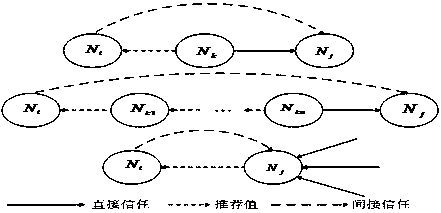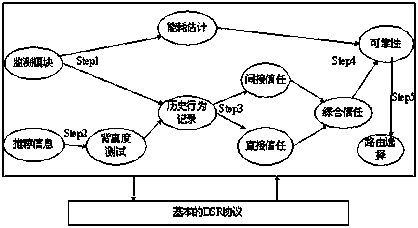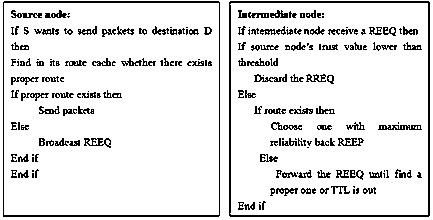A Cooperative Communication Method Based on Trust Evaluation in Mobile Ad Hoc Networks
A mobile self-organization and cooperative communication technology, applied in network topology, wireless communication, sustainable communication technology, etc., can solve problems such as unfairness and nodes not knowing when to recycle
- Summary
- Abstract
- Description
- Claims
- Application Information
AI Technical Summary
Problems solved by technology
Method used
Image
Examples
Embodiment 1
[0078] Trust Collaboration Methodology Implementation
[0079] We combine the proposed trust evaluation model with the DSR (Dynamic Source Routing) protocol in the mobile ad hoc network to verify the correctness and effectiveness of the trust evaluation model, and thus obtain a fair and safe DSR routing protocol based on Bayesian trust estimation FST-DSR (Fair Security Trusted DSR), the framework of the agreement is as follows figure 2 shown. How this trust model works and how trust changes as described in figure 2 The process shown proceeds:
[0080] Step 1: The monitoring module monitors the neighbor nodes, updates the historical behavior record information, and estimates its energy consumption. The historical behavior only records the packet forwarding situation of the node within a period of time.
PUM
 Login to View More
Login to View More Abstract
Description
Claims
Application Information
 Login to View More
Login to View More - R&D
- Intellectual Property
- Life Sciences
- Materials
- Tech Scout
- Unparalleled Data Quality
- Higher Quality Content
- 60% Fewer Hallucinations
Browse by: Latest US Patents, China's latest patents, Technical Efficacy Thesaurus, Application Domain, Technology Topic, Popular Technical Reports.
© 2025 PatSnap. All rights reserved.Legal|Privacy policy|Modern Slavery Act Transparency Statement|Sitemap|About US| Contact US: help@patsnap.com



